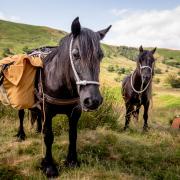The traditional ways make good horse sense to a family-run logging firm from Grange

Mighty Bolero tucks his head down and immediately responds to his handler's gentle twitch of the long reins. Two-thirds of a ton of surging muscle, he pulls two tree trunks up the slope from the shore of the lovely High Dam tarn high in the fells near Finsthwaite in the southern Lake District.
Yet this gentle giant leaves barely a hoof-print on the sensitive environment he is helping to steward. The 15.2 hands high black stallion is one of five North Swedish horses owned by the Lenihan family, based at Witherslack near Grange, who have persevered with their ecological logging company for 30 years.
Only now are authorities and others realising horse power is not only better for the environment but more efficient and ultimately cheaper than their mechanical rivals.
'People look upon the use of horses in a romantic or nostalgic way of working,' says Simon Lenihan. 'Nothing could be further from the truth. Especially in these days of environmental awareness, using horses is the most modern way of timber harvesting today.

'It is sustainable, carbon neutral and powered by nature, in the form of hay and grain, of which the by-products go straight back into the soil. Ecologically they are as near perfect as you can get.'
Simon set up the firm with his wife Katherine. Their six sons are now all involved in the business. One of the first to wake up to their potential was Prince Charles who has been championing the Lenihans since coming across their work at Tarn Hows, near Coniston, for the National Trust, back in 2007.
The family and their horses have since worked on the Duchy of Cornwall Estate, Dumfries House and Balmoral for the Prince and when the heir to the throne guest edited a national magazine for his 65th birthday he named the family as one of his ten champions of the countryside.
For years the Lenihans have been under-cut by the big machinery operators who seem to offer lower prices for land-owners. But the machinery can destroy vast areas of plant life and necessitate huge costs in restoration of the land. They can even damage the wood they have cropped.

Simon says the sensitivity is especially important in upper catchment areas where indiscriminate logging can lead to run-off and flooding downstream.
'Big machines have their place, but, usually, other big machines then have to come in and repair the damage. None of us has the right to destroy the forest. We recognise mechanised harvesting will be the main mover, but on sensitive sites of archaeological importance or by rivers and watercourses, horses are best.'
The area is owned by Lake District National Park Authority. South Lakes area ranger, Sara Spicer, says: 'We wanted to thin the larch to let more light in and encourage more wild flowers and shrubs. Using horses ensures the work is done sensitively. We didn't want it damaged by tractors. The horses can cope with the rough terrain and remove the logs without damaging them.'
The Lenihans formerly used a Belgian breed but have now switched to North Swedish, which have been bred for forestry for hundreds of years.
The Lenihans themselves have an unbroken use of horse power going back at least three hundred years, originally in Ireland. They moved across from County Limerick 30 years ago. 'I come from a family steeped in tradition in working with draft horses,' Simon says. 'I was lucky in that I grew up when working horse were still the main power source.
'I believe these early years of quietly working the land with my father and grandfather ignited my passion later in life to take up working with horses full time. Now the added bonus of my sons taking up the profession, it is refreshing to know the next generation will carry on looking after our forests with these magnificent animals.'
While Simon and his sons operate their horse logging in the woods, Katherine looks after the house and farm. She also crucially cares for the breeding mares so their off-spring are easier to handle and work.
Bolero is a perfect example of her craft, bred at Witherslack he is now aged 11 and in his prime. He loves grass, has perfect manner and loves to work. He can pull his own weight in logs. There are three other stallions, Therja, Jasper and Hvitserk and a mare which is in foal to Therja.



























